Jane Austen Bath Tour
In July of 2001, I went to England for research on my historical novel, A Spitfire Girl in Queen Victoria’s Court and A Feather in a Brook:
After seeing London, I took a train to Bath, England where Jane Austen once lived with her uncle. I signed up for the Jane Austen tour and put together this tour for my readers. It includes passages from some of Jane’s books concerning the town of Bath (I apologize for the lack of picture quality, but 2001 was before the current high-resolution pixel rate):
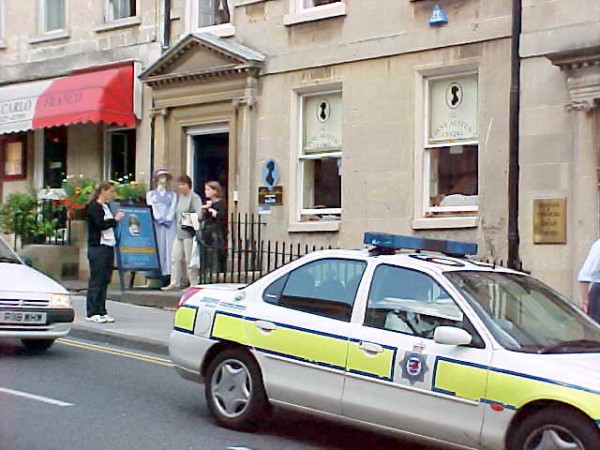
The Jane Austen Centre at No. 40 Gay Street. This is a house similar to the one Jane Austen lived in for a few months following her father’s death. It was just up Gay Street at No. 25.

Inside the Jane Austen Center. This display depicts male dress of the very early 1800s. On the table is strewn writing implements and paper.
On first entering Bath, Jane Austen wrote:
The first view of Bath in fine weather does not answer my expectations; I think I see more distinctly in the rain. The sun was got behind everything, and the appearance of the place from the top of Kingsdown was all vapour, shadow, smoke, and confusion.
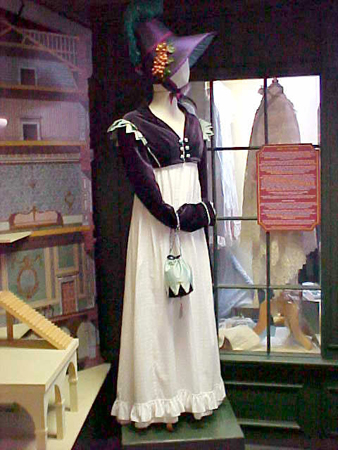
Inside the Jane Austen Center. This display depicts typical early 1800s female dress of the Regency Period.
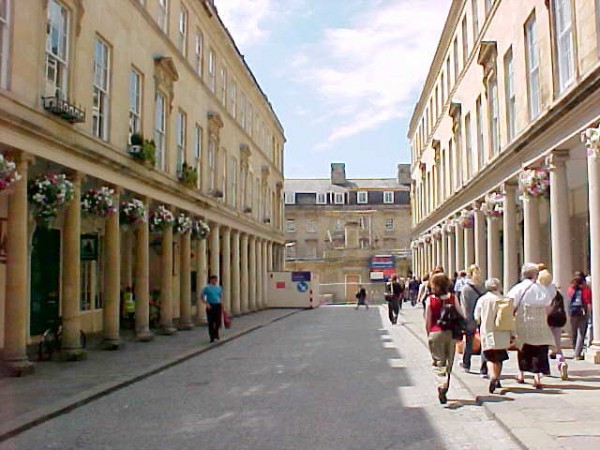
This is a typical street in downtown Bath. The buildings illustrate well the Georgian style architecture popular in the Regency Period.
Catherine Morland of Northanger Abbey describes Bath:
Here are a variety of amusements, a variety of things to be seen and done all day long, which I can know nothing of there….I really believe I shall always be talking of Bath–I do like it so very much….Oh, who can ever be tired of Bath.
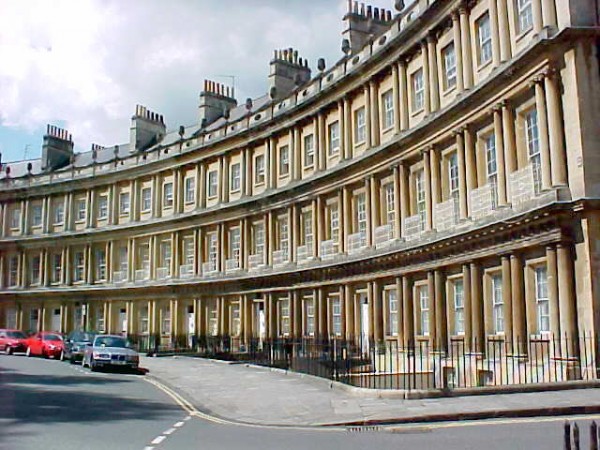
Bath is the location of Britain’s first circular street. The Circus, the first one, was constructed between 1754 and 1768. Started by John Wood, it was finished by his son, John Wood the Younger. The diameter of The Circus matched that of Stonehenge, the inspiration behind the curved architecture.
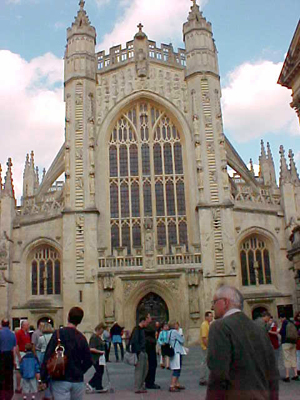
Bath Abbey, originally the site of a monastery built in 676 from the crumbling stones of old Roman buildings, the Abbey itself was erected in 1617. The statue carved above the entrance is of King Henry VII. On either side of the door are carved statues of St. Peter and St. Paul, to whom the abbey is dedicated.
Henry Tilney tries to disillusion Catherine Morland of Northanger Abbey:
Bath, compared with London, has little variety, and so everybody finds out every year. For six weeks I allow Bath is pleasant enough; but beyond that, it is the most tiresome place in the world. You would be told so by many people of all descriptions, who come regularly every winter, lengthen their six weeks into ten or twelve, and go away at last because they can afford to stay no longer.
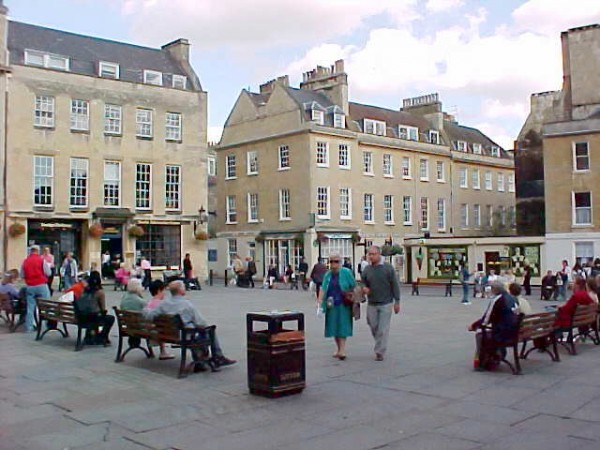
This is the area around Bath Abbey. It is spacious and open. The pump room, Roman baths, and museum are but yards away from the abbey.
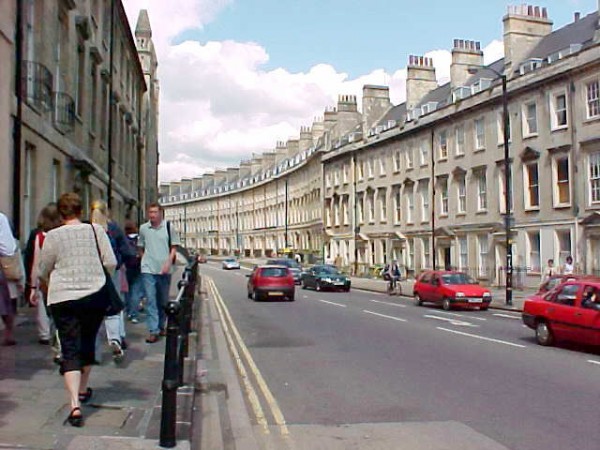
On Paragon Street, Jane stayed with her aunt and uncle, the Leigh Perrots, at No 1. She came to visit them and complained about the terrible view of the other houses from the front windows. Out the back windows, Jane was more pleased by the view of a garden.
In Persuasion, Anne Elliot may have expressed Jane’s true feelings of Bath:
Anne disliked Bath, and she did not think it agreed with her.
Again, she….dreaded the possible heats of September, in all the white glare of Bath.” (all the buildings when new were white and Jane complained that all the glare hurt her eyes)
As a girl, Jane had written: When first we came, all the umbrellas were up, but now the pavements are getting very white again. (17th May, 1799)
Mary Musgrove makes a similar remark: What dreadful weather we have had! It may not be felt in Bath, with your nice pavements; but in the country it is of some consequence.

The ballroom of the Assembly Rooms. It often would entertain over 1,000 guests at a time. Designed by John Wood the Younger, they opened in 1771. The chandeliers are said to be the finest in the world.
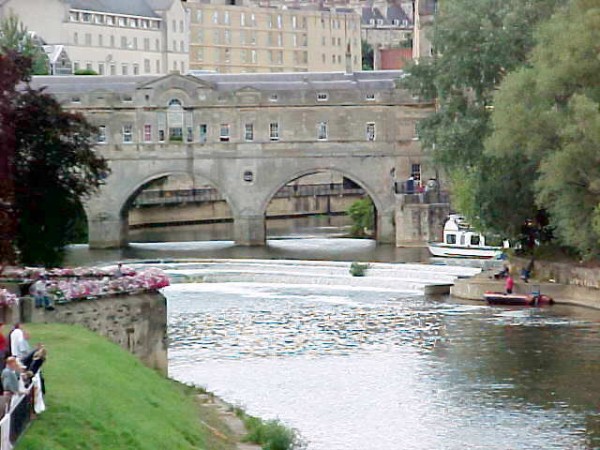
Completed in 1774 by Robert Adams, the Pulteney Bridge over the Avon River was the mastermind of developer William Pulteney who desired access to the grazing land of Bathwick. Pulteney wanted to build a new suburb, but finances dried up at the outbreak of war with France.
Admiral Croft in Persuasion said that Bath suited him very well:
We are always meeting with some old friend or other; the streets full of them every morning; sure to have plenty of chat.
Isabella Thorpe of Northanger Abbey felt differently:
Do you know I get so immoderately sick of Bath, your brother and I were agreeing this morning that, though it is vastly well to be here for a few weeks, we would not live here for millions.

This is an area called the Recreation Ground. It is just across the Avon River east of Bath Abbey and just south of the Pulteney Bridge.
THE END
Click HERE to return to the top.










